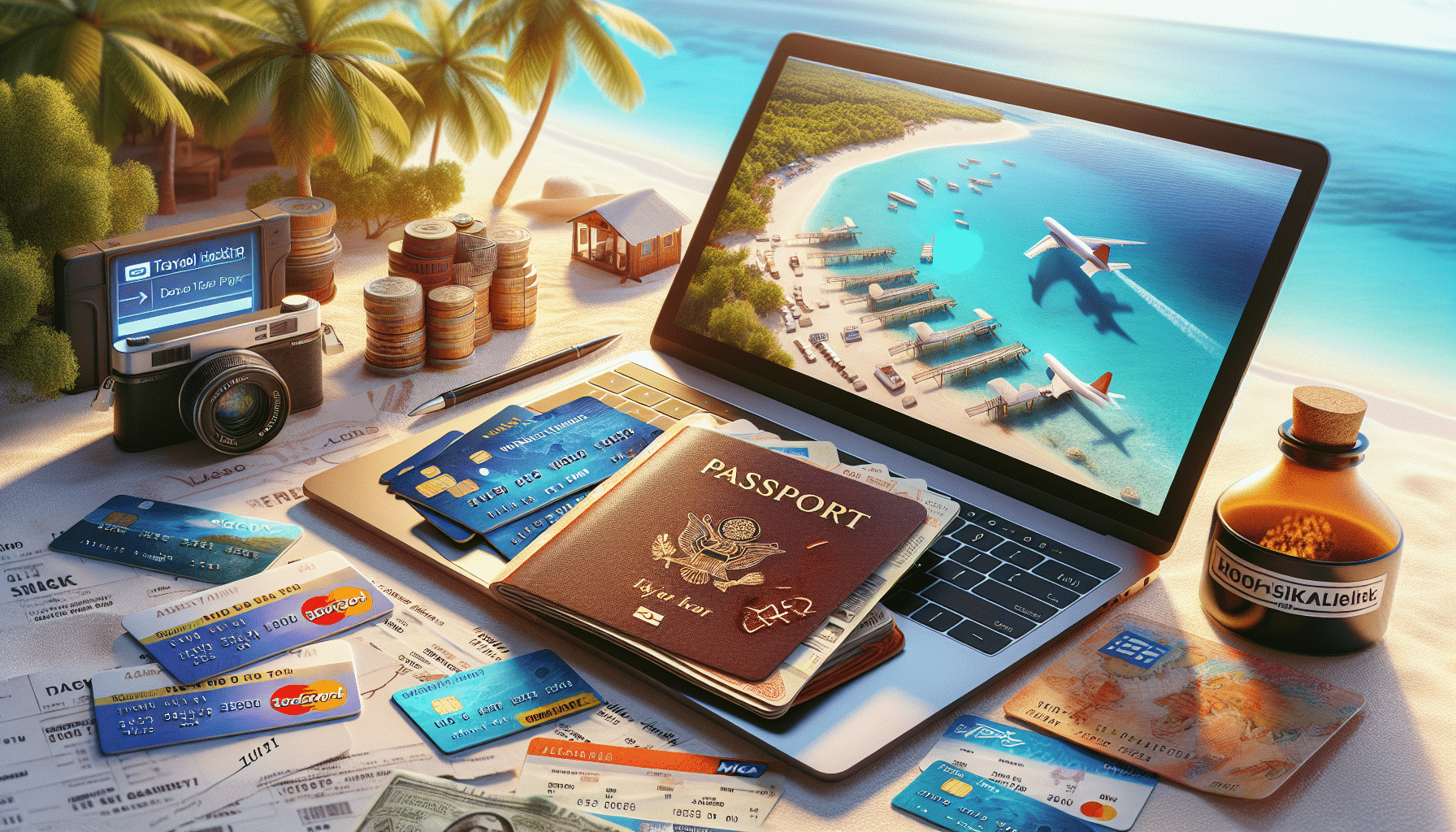Anúncios
Looking for some travel hacking tips to stretch your budget and see more of the world? You’re in the right place. Whether you’re new to gathering miles and points or you’ve dabbled in a few loyalty programs, there’s always more to discover. Let’s break down the essentials so you can leverage premium credit cards, alliances, and smart spending to unlock impressive travel savings.
Know the essentials
Before you get swept up in the excitement of free flights and hotel stays, it helps to clarify the two main types of points you’ll run into: Fixed Points and Transferable Points.
Fixed Points vs. Transferable Points
- Fixed Points: Typically bound to a specific airline or hotel loyalty program. You might earn these by focusing on a co-branded airline card or hotel card. Once you earn them, you can’t move them to other programs.
- Transferable Points: These come from premium bank programs like Chase Ultimate Rewards, Amex Membership Rewards, Capital One Rewards, or Citi ThankYou Points. You can shift them around to different airline or hotel loyalty programs. This flexibility often gets you more bang for your buck.
Let’s say you have something like 60,000 points in one of these premium programs. You might use them with your favorite airline one day, then apply them toward a hotel stay the next. If you’re hunting for the best redemption value, Transferable Points give you the freedom to pick the most favorable partner.
Why sign-up bonuses matter
Credit card sign-up bonuses (often called SUBs) are the rocket fuel of travel hacking. Some cards offer 75,000 or even 100,000 points after you meet a minimum spending requirement. That’s enough to land business-class seats or multiple domestic flights. If you pace yourself and open new cards thoughtfully, you can collect large sums of points throughout the year.
Yet, the golden rule applies: always pay off your balance in full. Carrying a balance adds interest costs that quickly wipe out your travel gains.
Compare credit card programs
Not all points-earning cards are created equal. Some cards focus on airlines, while others give you broader flexibility. To help you see the differences, here’s a mini comparison table of four major programs that offer Transferable Points. Consider checking out the best travel credit cards once you know what you need most.
| Provider | Major Transfer Partners | Annual Fee Range | Unique Perk |
|---|---|---|---|
| American Express | 20+ airlines/hotels | $95–$695 | Premium lounge access and higher-tier concierge benefits |
| Chase | 13 airlines/hotels (Hyatt, Southwest) | $95–$550 | Offers transfers to unique partners like Hyatt and Southwest |
| Capital One | 17 airlines/hotels | $95–$395 | Includes Capital One Lounge access and annual travel credit |
| Citi | 15+ airlines/hotels (no American Airlines) | $95–$495 | Flexible ThankYou Points that can bundle with other Citi perks |
When choosing a card:
- Weigh the annual fee against perks like lounge passes and travel credits.
- Check if a card aligns with the airlines or hotels you use the most.
- Look for sign-up bonuses that suit your upcoming spending needs.
Credit cards are pivotal in travel hacking because your everyday purchases magically turn into flights and hotel stays. You can also explore hotel rewards programs if a cozy suite is at the top of your wish list.
Maximize airline alliances
Another essential piece of the puzzle is airline alliances. These alliances include groups like SkyTeam, Star Alliance, and Oneworld. They let you book flights with one airline’s loyalty program and actually fly on a partner airline. That means if you have points in a single airline’s account, you can potentially book flights all around the globe.
How airline alliances help
- You gain access to more routes. By using airline loyalty programs cleverly, you can reach remote destinations without juggling multiple accounts.
- You save points when partner redemptions cost fewer miles than booking straight through your primary airline.
- You can collect or redeem miles with airlines you don’t fly frequently, as long as they’re in the same alliance.
For instance, if you focus on collecting miles with one Star Alliance carrier, you could still fly Lufthansa, United, Air Canada, Swiss, or Turkish Airlines by dipping into those miles. This can open up more flight options for a fraction of the price compared to paying cash.
Redeem points for maximum value
Earning points and miles is only half the story. Next, you’ll want to cash them in so you can see that value in action. This is where redemption strategy comes in.
Look for sweet spots
Each airline’s award chart has its own set of rules and sweet spots. You might find that a First Class seat costs way fewer points with a certain airline partnership versus another. You’ll often see the best value when you transfer your credit card points to an airline or hotel partner, rather than booking directly through your bank’s reward portal.
Many travelers report scoring 4 or 5 cents per point value when transferring to a partner. That’s a huge jump over the typical 1 cent per point through a bank’s travel portal.
Don’t forget about hotels
Sure, flights get most of the attention. But hotel stays can be the most expensive part of your trip, especially in big cities. When you transfer your bank points to a hotel program, you might nab five-star hotels for the cost of a budget property. This is especially true if you’re using high-value chains such as Hyatt or Marriott. Research also shows that redeeming for mid-tier properties can bring some of the best value, since luxury resorts sometimes require a hefty chunk of points.
Explore affiliate programs
Beyond flights and hotels, you can sometimes redeem points for travel activities, rental cars, or even certain premium experiences. This is where alliances, plus your Transferable Points, really show their flexibility.
Plan your trip strategically
When you’ve got the raw materials for your next adventure—points and miles—it’s time to piece together the actual journey. Turning “someday” into flight confirmations and hotel reservations feels fantastic. Here are a few ways to make it happen:
Pick a place
Begin with a goal destination. Maybe you’ve always wanted to lounge on a beach in Hawaii or explore the hidden gems of Lisbon. By choosing a specific spot, you’re putting a target on your travel calendar.
Check your calendar
Your job, family schedule, or personal obligations might dictate when you can pack up and leave. Give yourself enough lead time to find award availability. Generally, if you can swing flexibility in your dates, it’s easier to land cheaper mileage deals.
Nail down your bookings
Once you find good award seat availability (or that perfect hotel redemption), don’t spend too long debating. Whether it’s a discount on miles or a lower-tier redemption night for a gorgeous hotel, these deals can come and go quickly. Book your flights, then look at elite status benefits if you want extras like lounge access or priority boarding.
Pin your dates
As soon as you lock down your flights, mark those dates on your calendar and mentally commit. Studies suggest that simply having a trip on the horizon can boost your happiness levels, so pin it and enjoy the anticipation!
Earn and burn
A major pitfall new travel hackers face is hoarding points without ever spending them. The best travel hacking tips encourage you to earn and burn. In other words, pick your next amazing trip, redeem your points, and make unforgettable memories. Points and miles can be devalued by programs over time, so holding them too long risks losing value.
The Chase 5/24 rule
If you’re eyeing multiple new credit cards, remember that Chase has a “5/24 rule.” This restricts approvals if you’ve opened 5 or more credit card accounts with any bank in the past 24 months. Business cards often don’t count toward that total, so it’s a way to slip in an extra sign-up bonus if you qualify.
Minimum spend requirements
Most credit card bonuses require you to spend a certain amount, like $4,000, within the first few months. You can plan your big purchases—like electronics or annual bills—to coincide with opening a new card. This helps you meet the spend threshold without forcing extra, unnecessary expenses.
Practical steps for your first trip
Now that you have an overview, let’s simplify the process into clear, step-by-step actions.
- Choose your dream destination and timeline.
- Sign up for a rewards card that aligns with your travel goals. Be sure you can handle the minimum spend to trigger the sign-up bonus.
- Research your Transferable Points. Decide which airline or hotel partner offers the best redemption for your chosen trip.
- Check alliance partners for availability. Sometimes the best deals are with partner airlines, not just the main carrier you collect miles from.
- Book as soon as you see a great points deal. Remember, award seating can vanish quickly.
- Pay off your card balances monthly. Avoid interest charges—it’s the fastest way to ruin your cost-savings.
- Rinse and repeat. Once you’re done, start planning your next trip, or open a new card if it fits your strategy.
If you’re just beginning, don’t try to learn everything at once. Start with basic milestones: pick a place, open a suitable card, and meet the bonus requirements. You can always refine your approach later.
Take advantage of card perks
Credit cards these days often go beyond mere points. Some cards bundle perks like:
- Airport lounge access (including Priority Pass lounges)
- Free or discounted TSA PreCheck or Global Entry
- Travel credits to offset hotel and flight costs
- Companion passes that let a friend fly with you for just the cost of taxes
- Insurance for trip delays or lost baggage
These benefits help justify the annual fees you might pay. For example, the Capital One Venture X card carries a $395 annual fee, but you get a $300 travel credit plus bonus points each year, and those perks can easily exceed the cost in value. Always do the math on how much you’ll realistically save using these extras.
Learn about hotel loyalty programs
A big part of travel hacking is finding a great place to stay for next to nothing. Many hotels have loyalty tiers that give you free Wi-Fi, room upgrades, or late checkout. Or, you can earn points faster with a co-branded hotel credit card.
- Marriott Bonvoy: Provides a huge network of properties from budget-friendly to ultra-luxurious.
- Hilton Honors: Known for frequent promotions and easy points registration.
- Hyatt: Highly regarded for sweet spots on award nights, especially at upscale properties.
When you transfer points from Chase Ultimate Rewards to Hyatt, for instance, you can often snag award stays at top-tier hotels at less cost than other chains. That’s real savings every night you’re on the road.
Credit score and responsible usage
One stumbling block for newbies is worrying that opening multiple credit cards will tank their credit. The truth is, regularly paying off your balance on time can help your credit score in the long run. You might see a temporary hit when you open a card, but consistent, on-time payments and responsible usage typically boost your score over time.
Paying off balances
Use calendar reminders or automatic payments. If you pay late, you risk fees and interest charges, which can quickly erase the value of your earned points. Think of it this way: every saved dollar in points is wasted if you’re paying steep interest on your card bill.
Improving credit
If your credit score could use some work, it pays to understand the basics:
- On-time payment history is the biggest factor.
- Credit utilization ratio matters. Keep that as low as possible by paying balances promptly.
- Length of credit history helps, so keep seasoned accounts open if possible.
Once you have a solid payment track record, you’ll be in a good position to apply for higher-tier cards with larger bonuses.
Diversify your earning strategies
Credit cards carry the biggest punch, but there are other ways to earn miles and points on top of your usual spending.
Shopping portals
Many airlines have online portals that give you bonus miles when you shop at partner retailers. If you’re about to buy a new laptop anyway, a few clicks could net you extra points without any extra cost.
Dining programs
Certain airlines or hotel brands also give you miles if you dine at partner restaurants. Register your credit card, then eat out as you normally would. It’s a small but easy boost.
Referral bonuses
Sometimes you can refer a friend to a credit card you love. If they get approved, you’ll each earn bonus miles. It’s a win-win for both parties.
Avoid common pitfalls
- Redeeming for poor value: If your card provider offers only 1 cent per point through their travel portal, consider transferring your points to an airline or hotel partner for a better redemption rate.
- Hoarding points forever: Programs can devalue, so use those points while they’re worth the most.
- Overspending to meet a bonus: If you’re stretching your finances just to meet a sign-up requirement, you risk carrying a balance. Plan your card openings around big expenses you already have in mind.
Real-world example
Imagine you want to fly from New York to Barcelona and accommodations for a week. Let’s sketch out how you might pull that off:
- You open a premium card with a 75,000-point bonus after spending $4,000 in three months.
- Your usual grocery, gas, and utility bills over three months hit that spending mark. You now have 75,000 new points.
- You keep an eye on flight award charts. Maybe you find a steal with an alliance opportunity, transferring your bank points to a partner airline that charges fewer miles than booking directly.
- Instead of paying $1,000+ for a round-trip flight, you fork over 50,000 miles and a small amount in taxes.
- With leftover points, you transfer enough to get a few free nights in a Hyatt property near Barcelona’s city center. Instead of a $300-per-night expense, you pay in points.
That’s the magic of travel hacking: turning your usual monthly spending into a nearly free trip.
Keep the excitement alive
Sometimes travel hacking becomes a lifestyle. Once you see how you can visit bucket-list spots without breaking the bank, you might never go back. But remember:
- Treat miles and points as currency. They have real value, so make them count.
- Keep track of program changes, because terms shift regularly.
- Enjoy the perks, but don’t get greedy. Travel hacking should help you see the world, not bury you in credit card debt.
If you’re curious about day-to-day spending optimizations or want a deeper comparison of available cards, revisit the best travel credit cards. Or, if you’re aiming for upgrades and extra pampering, elite status benefits might be your next strategic angle.
Final thoughts
Starting out with travel hacking might feel overwhelming, but it’s really about taking it one trip at a time. Pick your dream destination, snag a strong sign-up bonus, and redeem your points in a way that puts a smile on your face. Over time, you’ll learn which rewards programs fit your goals best.
The biggest piece of advice? Use your points. They’re meant to get you on a plane, into a comfy hotel room, and off exploring faraway spots. So jump in. Collect some miles, find an airline partner that works for you, and pin those travel dates on your calendar—even if they’re months away. You’ll soon see that the most valuable part of “travel hacking tips” isn’t just saving money, it’s creating memories you’ll cherish forever. Safe travels, and remember to enjoy the journey!








